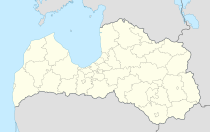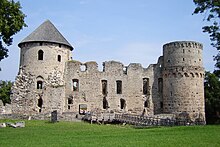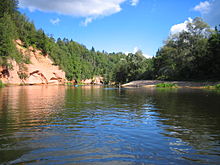Cēsis
| Cēsis ( Eng .: To turn) | ||
|---|---|---|
 |
|
|
| Basic data | ||
| State : |
|
|
| Landscape: | Livonia ( Latvian : Vidzeme ) | |
| Administrative district : | Cēsu novads | |
| Coordinates : | 57 ° 19 ' N , 25 ° 17' E | |
| Residents : | 17,170 (Jan. 1, 2016) | |
| Area : | 19.280 km² | |
| Population density : | 891 inhabitants per km² | |
| Height : | 119 m | |
| City law: | since the 13th century | |
| Website: | www.cesis.lv | |
| Post Code: | LV-4101, LV-4103 | |
| ISO code: | LV-022 | |
| City center | ||
Cesis ( , German Wenden , Liv Venden , Estonian Võnnu , altostslawisch Кесь , Russian Цесис , Polish gravel ) is a town in northern Latvia . It is located on hills and terraces above the Gauja at the northern exit of the Gauja National Park .
history
middle Ages
Cēsis was first mentioned in a document in 1224. Between 1281 and 1284 St. John's Church (Lat .: Jāņa baznīca ) was built. Its location on the Gauja River and on the Riga - Pleskau trade route encouraged its rapid development into a flourishing trading city. In the 14th century, Cēsis joined the Hanseatic League . The market square and the church formed the center of the city. A wall made of dolomite with eight towers and five gates surrounded the town and castle.
Modern times
In 1524 the first Lutheran service was held in Cēsis. In 1561 the Livonian estates, including the city of Cēsis, submitted to the Polish King Sigismund I August in view of the Russian threat . In return , he assured them, in the Privilegium Sigismundi Augusti, of free religious practice, self-government under German law ("Teutsche Magistrat") and the indigenous (the occupation of offices with locals). His successor, King Stefan Batory did not stop because he tried to Livonia re-catholicize . In 1582 he founded the Catholic diocese of Wenden .
In 1590 one of the oldest Baltic breweries was founded in Cēsis. In the meantime, the city became the capital of a voivodeship in what is now the Duchy of Livonia after Prince Sigismund III. Wasa acquired Livonia for Poland-Lithuania in 1598 . In 1621 Cēsis was conquered by the Swedish King Gustav II Adolf . In 1671 and 1748 the city was considerably destroyed by large fires.
In the second half of the 19th century, the construction of the trunk road between Rīga and Pleskau (Lat .: Pleskava ) in 1868 and the railway line Rīga - Valka in 1889 promoted the development of the town. The Ronneburger (Lat .: Raunas ) street between the train station and the old town was laid out as a wide boulevard with the house of the Latvian society (architect: A. Malvess; no.10), the building of the local court (architect: P. Mengelis; no. 14) as well as other important buildings.
The Battle of Cēsis , in which Latvians and Estonians inflicted defeat on German troops in June 1919, was a crucial event in the Latvian War of Independence .
Cēsis also developed into a health resort. Elegant summer houses and sanatoriums were built near the Gauja, including Cīrulīši near the Svētavots Cave, the source of which is said to have healing powers. Cēsis advertises its preserved old town and is the starting point for trips to the surrounding national park. In 2007, numerous buildings were restored on the occasion of the 800th anniversary.
The castle park with castle hill and ruins
The oldest settlement in Cēsis was a wooden fortification of Latgale on a hill in what is now Castle Park.
German crusaders of the Order of the Brothers of the Sword began building Wenden Castle near the old wooden castle after 1212. After the stone order castle with its three fortified bailies had been enlarged and fortified, it served with various interruptions from 1237 to 1561 as the residence of the Livonian Landmeister of the Teutonic Order and was thus one of his headquarters. In 1577 the garrison and part of the castle blew themselves up when Cēsis was besieged by Ivan the Terrible's troops . The facility was then rebuilt, but finally abandoned in the Great Northern War .
As early as the end of the 16th century, the castle buildings had been adapted to the requirements of an agricultural property . After the property was bought by Johann Gottlieb von Wolff in 1755 , his family built a mansion as a new residential building in the eastern area of the castle and integrated the remains of an old defensive tower into it . When the property was taken over by Count Karl von Sievers in 1777 , he had a landscape garden laid out west of the castle from 1812 to 1815 . This has the usual romantic features of a garden of that time: winding footpaths, strange plants and a pond in which the castle ruins are reflected.
Since 1949 the Cēsis History Museum has been located in the 18th century mansion known as the “New Castle”. The forecourt of the New Palace is enclosed by a granary and a coach house , the latter today houses an exhibition hall of the museum. The oldest brewery in Latvia is located next to the granary. It was built in 1878 at the time of Count Emanuel von Sievers , but its origins go back to the time of the order.
Cradle of the Latvian national flag
According to tradition, the Latvian King Visvaldis was wounded here in the fight against foreign invaders. When he lay down on the white flag of surrender and died, his blood stained the flag to the right and left of his body a deep red. Where the king's body lay, the banner remained white. The red-white-red banner has been attested in writing since 1270.
After 1870 it became the Latvian national flag .
traffic
Cēsis has a train station on the Riga – Valka railway line .
Town twinning
There has been a town partnership between Cēsis and Achim (Weser) in Germany since 1992 . Further town twinning has been maintained with Tyresö ( Sweden ) and Venafro ( Italy ) since 1991, and with Rokiškis ( Lithuania ) since 2000 .
Lakes and rivers
The Gauja flows about 3 km west of Cēsis.
Cēsu novads administrative district
In 2009, together with the rural community of Vaive, the administrative district of Cēsu novads was formed .
sons and daughters of the town
- Johann Graf von Sievers (1778–1827), Russian general
- Emanuel Graf von Sievers (1817–1909), Russian senator and chief steward
- Heinrich Leonhard Adolphi (1852–1918), German-Baltic pastor and chess composer, Evangelical Lutheran martyr
- Alfrēds Kalniņš (1879–1951), composer
- Max Hildebert Boehm (1891–1968), sociologist
- Eduard Erdmann (1896–1958), German pianist and composer
- Wilhelm Lenz (1906–1976), German-Baltic historian
- Adolf Rüütel (1906–1981), Estonian national soccer player
- Anita Stukāne (* 1954), Soviet long jumper
- Laima Vaikule (* 1954), singer
- Edvīns Ķeņģis (* 1959), chess player
- Ingrīda Amantova (* 1960), Soviet luge athlete
- Pauls Bankovskis (1973–2020), writer, journalist and publicist
- Vita Heine (* 1984), Latvian-Norwegian racing cyclist
- Gerda Krūmiņa (* 1984), biathlete
- Baiba Bendika (* 1991), biathlete
literature
- Hans Feldmann , Heinz von zur Mühlen (Hrsg.): Baltic historical local dictionary, part 2: Latvia (southern Livland and Courland). Böhlau, Cologne 1990, ISBN 3-412-06889-6 , pp. 690-693.
- Jegór von Sivers: Wends, its past and present. A contribution to the history of Livonia . Nicolai Kymmel , Riga 1857. Reprint: v. Hirschheydt, Hannover-Döhren 1975, ISBN 3-7777-0852-6 .
- Erich Seuberlich : Notes on Wendens citizens up to the year 1773. According to the church book of the city of Wenden in Livonia and Pastor Heinrich Baumann's manuscripts . Vogt, paper mill 1907.
- Baltic countries - travel guide , Michael Müller Verlag, Erlangen 2008, ISBN 978-3-89953-380-4 , p. 368 ff.
Footnotes
- ^ Heinrich von Hagemeister : Materials for a History of the Estates of Livonia , Volume 1, Eduard Frantzen, Riga 1836, p. 179.
- ↑ Jegór von Sivers: Wenden, his past and present. A contribution to the history of Livonia . Nicolai Kymmel, Riga 1857, p. 20.
- ↑ Reinhard Wittram : Baltic history. The Baltic countries of Livonia, Estonia, Courland 1180–1918 . Oldenbourg, Munich 1954, p. 81.
- ↑ Hans Feldmann, Heinz von zur Mühlen (ed.): Baltic historical local dictionary, part 2: Latvia (southern Livland and Courland). Böhlau, Cologne 1990, p. 690.
- ^ Entry by Ieva Ose on Cēsis in the scientific database " EBIDAT " of the European Castle Institute
- ↑ Reinhard Wittram: Baltic history. The Baltic countries of Livonia, Estonia, Courland 1180–1918 . Oldenbourg, Munich 1954, p. 29.
- ↑ Reinhard Wittram: Baltic history. The Baltic countries of Livonia, Estonia, Courland 1180–1918 . Oldenbourg, Munich 1954, p. 76.
- ↑ Detailed castle history by the historian Agris Dzenis , accessed on December 29, 2019.
- ^ History of the manor on the castle website , accessed December 29, 2019.
Web links
- Wenden / Cēsis in the online lexicon on the culture and history of Germans in Eastern Europe





